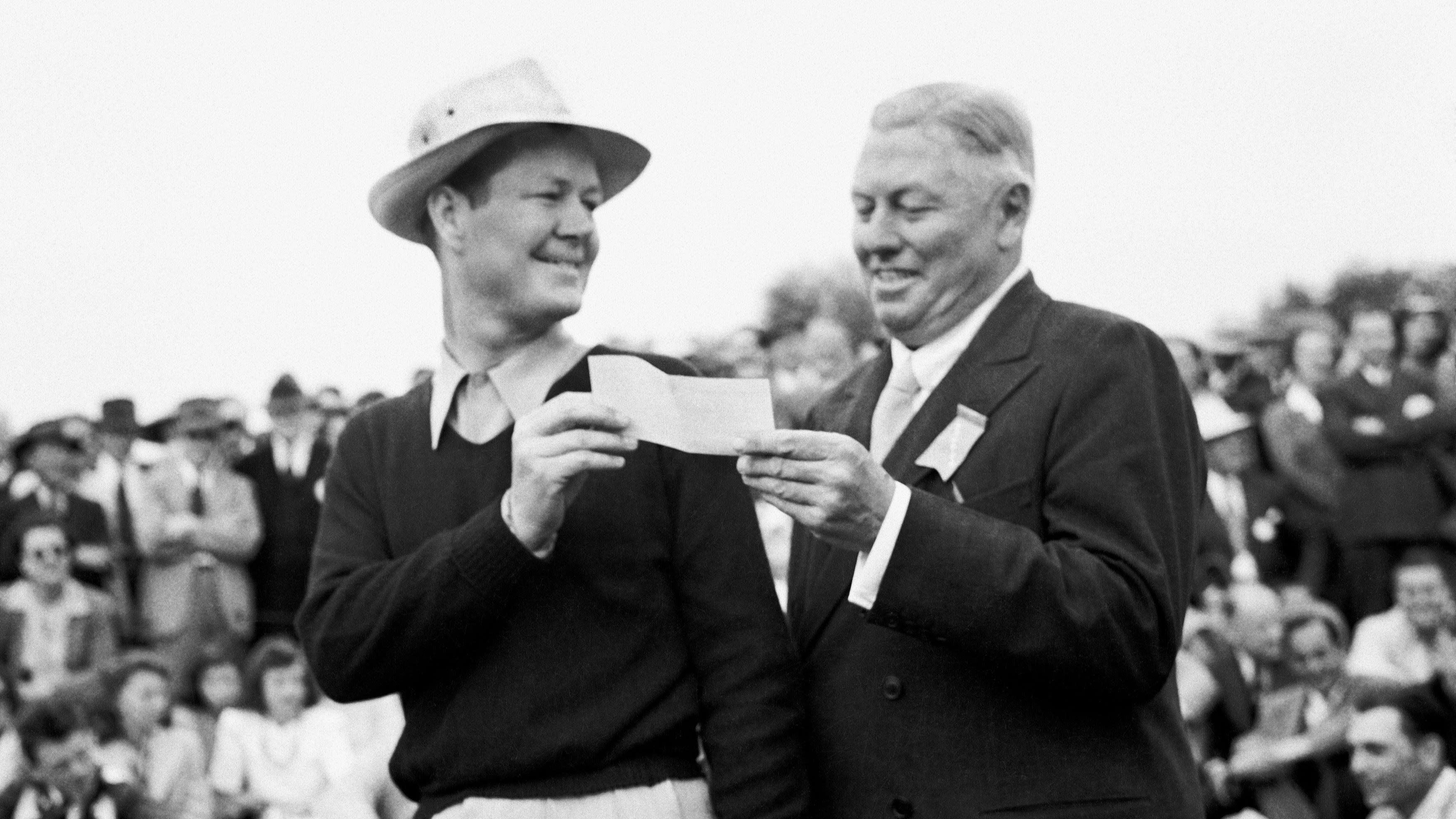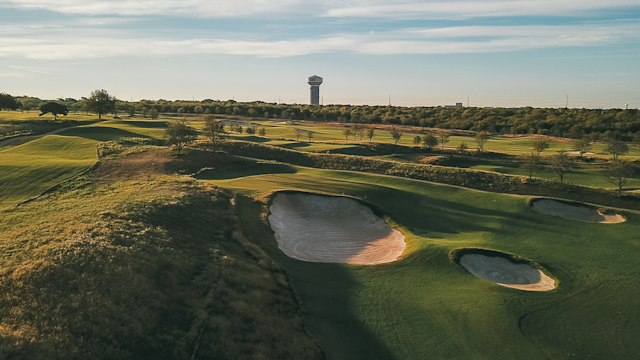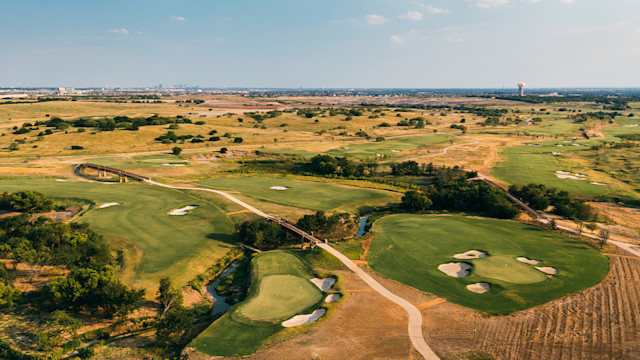Events
Born at Augusta National: The Story of the KitchenAid Senior PGA Championship and Its Trophy
By Bob Denney
Published on

Byron Nelson stands with Alfred Bourne during the 1937 Masters. Bourne played an integral role in starting the Senior PGA Championship. (Augusta National/Getty Images)
Alfred Severin Bourne, a man who left an imprint upon golf history behind the scenes and his name on the trophy presented to the Senior PGA Champion, was a quiet philanthropist. He was a friend of the PGA club professional, and enjoyed golf, hunting and boating as a release from any concerns of maintaining investments on Wall Street during uncertain times.
A legacy of generosity
Bourne was one of nine surviving of the 13 children born to Frederick and Emma Bourne. Frederick Bourne served as president of Singer Sewing Machine Company from 1889 to 1905, a business leader of a powerful worldwide brand. Upon his death, Bourne passed to his children a large estate along with a spirit of rich generosity, a trait carried on by his son, Alfred.
Bourne and his wife maintained a primary residence in Washington, Conn., where Alfred developed his golf game. The couple began spending winters in the mild climate of Augusta, Ga., and their daughter, Barbara, would marry one of the most promising professional golfers in the country, Horton Smith, four years after he captured the inaugural Masters in 1934.
Bourne and his wife maintained a primary residence in Washington, Conn., where Alfred developed his golf game. The couple began spending winters in the mild climate of Augusta, Ga., and their daughter, Barbara, would marry one of the most promising professional golfers in the country, Horton Smith, four years after he captured the inaugural Masters in 1934.
A talented and avid golfer
Bourne’s journey to Augusta National Golf Club began through Augusta Country Club, where he often played with friends Fielding Wallace, a future USGA president, and PGA Professional David Ogilvie. Bourne captured the club championship four consecutive years (1922-1925). Bourne and Wallace maintained a close friendship with Augusta’s esteemed part-time resident, the legendary Bobby Jones.
A large (accidental) gift
Jones invited Alfred and Wallace to become founding members of Augusta National. Annual dues for membership started at $60 per year and the initiation fee was $350. Those who underwrote the club signed a firm commitment for a minimum of $5,000 and a goal of $50,000. However, in a mission to solicit Bourne, the committee chairperson mistakenly stated a request of $50,000 instead of $5,000, which Bourne provided the next morning.
“Grandfather was a philanthropist from the start, but was very quiet and not a showman,” said granddaughter Nancy Bourne Swan of Highlands Ranch, Colo. “I was very young when I spent time with him, but I sensed that his love of golf went way back.
“Grandfather was a philanthropist from the start, but was very quiet and not a showman,” said granddaughter Nancy Bourne Swan of Highlands Ranch, Colo. “I was very young when I spent time with him, but I sensed that his love of golf went way back.
Instrumental in growing the golf club
Bourne did not forget his friends at Augusta Country Club, serving as an officer on the club’s board of governors, and among his donations was a portion of his property for relocation of the tennis courts. In 1928, he oversaw the construction of a golf shop. The white cedar-shingled building was donated by Bourne to the club.
Prior to the inaugural Senior PGA Championship in 1937, Bourne, the Augusta National vice president, was given the idea of a championship cup by St. Andrews-born professional Jack Jolly. Bourne purchased a trophy from Tiffany’s for $1,500.
Prior to the inaugural Senior PGA Championship in 1937, Bourne, the Augusta National vice president, was given the idea of a championship cup by St. Andrews-born professional Jack Jolly. Bourne purchased a trophy from Tiffany’s for $1,500.
A formidable prize
The Alfred S. Bourne Trophy, one of the largest in golf, is a hefty 36 pounds, measures 18 inches wide and stands 42 inches. It is a centerpiece of a Championship that preceded the birth of the Champions Tour by 43 years.
It wasn’t until May 2010 at Colorado Golf Club that Nancy Bourne Swan first gazed upon the trophy. Without a formal escort, she walked up to the first tee and introduced herself to an official inside the gallery ropes at the Senior PGA Championship.
“Hi, I’m the granddaughter of the man whose name is on that trophy,” said Nancy, a retired teacher. “Can I get a closer look?” Resting on a wooden stand, the trophy sparkled in the rarefied air of the Rocky Mountains that day. “It’s a beautiful trophy,” said Nancy. “I know grandfather would be very proud of where it’s been and what it represents.”
It wasn’t until May 2010 at Colorado Golf Club that Nancy Bourne Swan first gazed upon the trophy. Without a formal escort, she walked up to the first tee and introduced herself to an official inside the gallery ropes at the Senior PGA Championship.
“Hi, I’m the granddaughter of the man whose name is on that trophy,” said Nancy, a retired teacher. “Can I get a closer look?” Resting on a wooden stand, the trophy sparkled in the rarefied air of the Rocky Mountains that day. “It’s a beautiful trophy,” said Nancy. “I know grandfather would be very proud of where it’s been and what it represents.”


